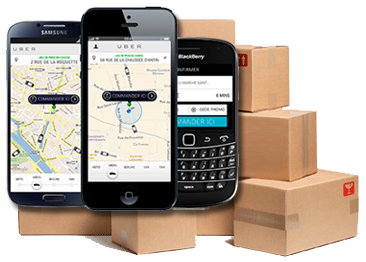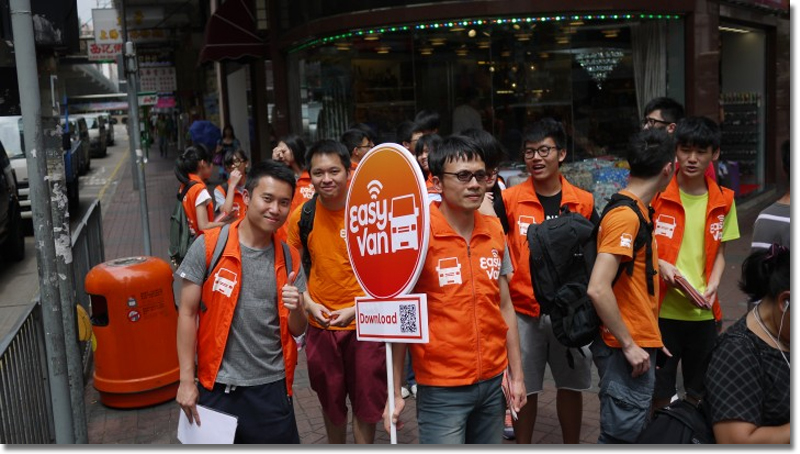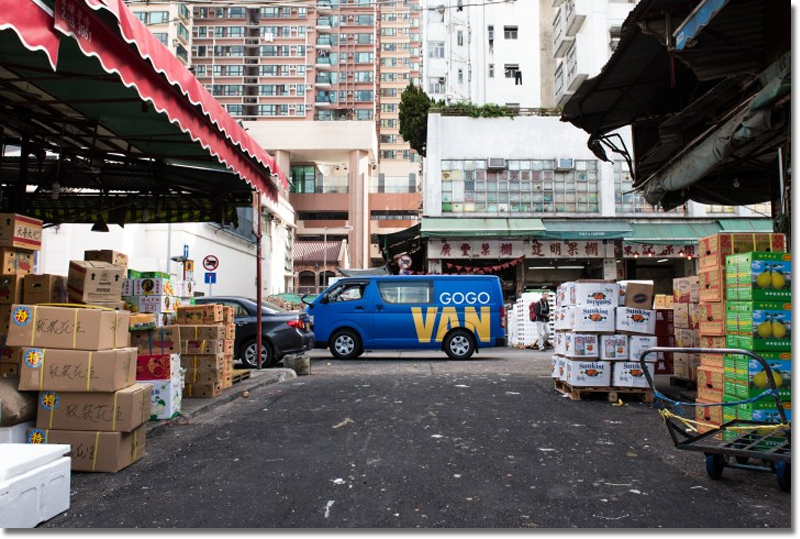‘Uber for Logistics’ is Already Happening in Asia, and Uber is Getting Left Behind
The excitement over the amorphous future of logistics is best exemplified by Uber, one of the most forward-thinking and controversial firms of this era.
Over the past two years, investors and entrepreneurs have demonstrated a renewed interest in logistics, both in the west and in Asia.
Amazon has hedged its bets on drones as the future of package delivery, investing over US$14 billion in the technology since 2010.
Startups like Postmates and Wunwun, along with valley giants like Google, Amazon, and Ebay have thrown their hats in the ring in hopes of realizing the elusive “Kozmo dream” – near-instant delivery of anything, anytime.
But it’s not just about ecommerce. The excitement over the amorphous future of logistics is best exemplified by Uber, one of the most forward-thinking and controversial firms of this era. Earlier this year, Uber’s charismatic CEO Travis Kalanick announced the company will eye logistics as its next frontier, stating, “We’re in the business, today, of delivering cars in five minutes. But once you’re delivering cars in five minutes, there’s a lot of things you can deliver in five minutes.”
Let’s think about this for a second – what will “Uber for logistics” look like exactly? The company recently opened a bike courier service called UberRUSH, but it was just an experiment. Kalanick has also waxed poetic on the beauty of self-driving cars, but those vehicles probably won’t become commonplace for ten or twenty years. “Uber for logistics” might also mean the company commits to Kozmo-esque delivery – ice cream, newspapers, and Starbucks on demand – but beyond brand clout (which shouldn’t be underestimated), there’s little evidence that Uber can add value to this already fragmented sector. Needless to say, a shiny Uber Mercedes won’t be used to deliver your pizza anytime soon.
In Asia, however, where the logistics industry remains less sophisticated than that of the US, “Uber for logistics” is already happening. Moreover, the companies offering logistics-on-demand face a market size that likely far exceeds the market for late-night fried chicken. By shunning fancy black cars in favor of no-frills white vans and trucks, Hong Kong’s Easyvan and Gogovan have beat Uber to the punch.
Uber Isn’t a Car Service. It’s the Future of Logistics
As reported by Adam Vaccaro, Bloomberg Businessweek, Uber’s long-term prospects dwarf cool cars and an easy-to-use app. Uber’s car service of today could form the backbone of a landscape-changing logistics, delivery, and travel company of tomorrow.

Uber, the on-demand car service has become beloved by consumers in urban areas for its sleek cars and easy-to-use app, but does innovating upon a basic taxi service really warrant the kind of hype—including $100 billion projections—it’s gotten in tech circles?
That’s a question Kevin Roose explored recently in an article for New York Magazine. The answer, Roose explains, is no. What warrants that projection is that Uber’s car service of today could form the backbone of a landscape-changing logistics, delivery, and travel company of tomorrow.
Looking at the Big Picture
“Eventually, like Amazon, it can become something akin to an all-purpose utility—it’ll just be a way you get things and go places,” Roose writes. “There’s a reason the company recently changed its tagline from ‘Everyone’s private driver’ to the much broader ‘Where lifestyle meets logistics.’”
The Amazon comparison is an easy one to make. What started out as an online bookstore in the early days of the Internet would eventually follow its nose to become one of the world’s more prominent retailers, web hosting services, and tablet maker—not to mention that whole drone thing.
History Repeating Itself
This comparisons spread offline. In November, The Atlantic compared Amazon’s model to that of Sears in the early 20th century. The retail powerhouse leveraged the burgeoning rail and road systems—as well as its hefty catalog—to dominate the retail marketplace as something far greater than a department store for the better part of the century, Derek Thompson explains.
Uber’s case is potentially global. The hype makes a lot more sense if it eyes becoming a global logistics powerhouse. As Roose writes, “In ten years, we might be scratching our heads: Wait, Uber used to be a car service?”
Source: Bloomberg Businessweek
Applying Logic to Logistics
The white van industry in Hong Kong bears a strong resemblance to the municipal taxi industries across the US. According to Gabriel Fong, executive chairman at Gogovan, about half of the city’s 70,000 commercial vans are registered with specific companies – meaning they’re not really for-hire. The remaining 35,000, however, are driven by “owner-operators” – in other words, freelancers.
These drivers might form contracts with a number of small-to-medium enterprises, but when business is slow, they rely on dispatch centers to receive orders from clients. A driver whose base camp is in Kowloon, for example, might pay a local call center HK$2,000 every month for permission to use radio transmission equipment and receive orders from the center’s phone lines.
Much like the taxi dispatchers in New York City, these call centers generally provide poor customer service and operate under seemingly arbitrary sets of rules. If I open the phonebook to look for a van that can move my couch, I’ll see a long list of call centers, each of which works only within a specific district in the city. So if I want my couch moved from Kowloon to the New Territories, I’ll have to run down the list and contact each center. If I’m lucky enough to find the one that serves my route, that’s still no guarantee that they’ll have a van available. This fragmented and inefficient system will surely give endless headaches for anyone looking to book a van in a pinch.
Gogovan and Easyvan bypass the call centers by providing a peer-to-peer app that connects van drivers with individuals or businesses who need their stuff shipped quickly. While the apps sport different user interfaces, the song remains the same, and if you know how Uber works, you can probably start singing along. Open the app, enter a pick-up location and destination, input special needs (“I’m moving my six pet mastiffs,” “Please bring two dolly carts”), and request a vehicle. After a customer submits an online pickup request, drivers on the network receive a notification on their smartphones and can choose to accept the offer directly.

Gogovan and Easyvan look set to knock over the call center industry like a bowling pin. Fong claims most of the old-fashioned call centers usually have about 20 to 50 vans on their networks, with the largest one topping out at 1,000. Meanwhile, Gogovan, which isn’t yet one year old, has 18,000 vans on its network, while Easyvan has 8,000. Each call center also faces overhead costs for buying and maintaining radio transmitters, along with rent for cellular tower space. But thanks to the magic of the internet, overhead costs for Easyvan and Gogovan are next to nothing.
The ingenuity behind Easyvan and Gogovan partially lies in the versatility of the vehicles they have on their networks – the van (or truck).
There might be the occasional customer who logs on to Gogovan to get his mattress moved from Kwai Tsing to Hong Kong Island. But the truly valuable Gogovan user is the local wire supplier who needs 500 mattress springs moved across town every week. Fong says that this enterprise focus helps ensure that no one bails on a booking – a common problem for drivers in cities like San Francisco, where transportation network companies (TNCs) have deep penetration and compete fiercely.
“Unlike taxi apps, our completion rate is nearly 100 percent. Our trips almost always get completed. The user can’t and won’t just go out on the street and try to flag down a van. Whereas for the taxi apps, you have a very high unsuccessful rate. People will just book rides on Uber and other apps and then get in whichever car comes first.”
Gogovan and Easyvan have tapped into such a rich opportunity that Kalanick and his crew should be banging their heads against the wall for missing out. When one considers the legal and regulatory issues Uber inevitably faces when it enters each one of its one hundred-odd markets, it’s a wonder why anyone would want to disrupt the taxi industry to begin with. Unless you love labor disputes and stodgy bureaucrats, working for a passenger-oriented TNC is probably not for you. But while politicians might bend over backwards to protect vested interests in the local taxi industry, you’ll be hard pressed to find a Mayor Quimby type who has ties to the White Van Call Center Association of Hong Kong.
Packing the Trunk
Currently, neither Easyvan nor Gogovan imposes any fees for use of their apps. Yet the dual focus on both consumers and enterprises opens the door for a number of different monetization routes. One obvious option includes charging commission fees on completed transactions, as Uber does. The companies might also implement SIM card-esque top-up fees on the drivers that use the app, as GrabTaxi does in certain markets.
But Gogovan, which has a six-month head start on Easyvan, is already thinking bigger. Fong predicts that as long as Gogovan can displace traditional van call centers and accumulate a critical mass of drivers on the app, the company can earn money from display ads on vans.
“If you look at Hong Kong – the minibuses, the taxis, and the buses – they all run with ads on the side of the vehicles,” says Fong. “Traditionally, vans have not had that, because as an individual freelance driver you have no negotiating power with any of the ad agencies. Now, with a platform of 18,000 van drivers, we suddenly have that. We’re now working with one or two ad agencies to create that new revenue channel, and we’ll also share some of that with the van drivers.”

That negotiating power easily converts into purchasing power. The beauty of the TNC business model lies in the firm’s ability to broker transactions (taxi rides or product shipments) so efficiently that drivers themselves will shoulder the costs of facilitating those transactions (vehicle maintenance and upkeep) in order to access the broker. But a powerful TNC can negotiate deals with diesel providers, vehicle repair shops, insurance companies, or any number of other businesses to pass savings along to drivers on the network.
Does this mean that national or global logistics providers like UPS and FedEx should quiver in fear? On the contrary, the arrival of Gogovan and Easyvan marks a cause for celebration. Vans on these networks specialize in “last-mile delivery,” usually the most expensive but most crucial leg of any product transport. UPS and FedEx likely have logistics networks sophisticated enough to get a package from New York City to rural New York State in no time. But what about from Hanoi to rural Vietnam? Fong says:
Major logistics companies in Hong Kong are all using our services. These logistics firms outsource about 70 percent of their logistical requirements. They own the entire logistics chain except for last-mile delivery. Just imagine – if these logistics companies owned every truck that they need, not only would they have to buy and maintain more trucks, but they’d have to hire lots of drivers to drive those vehicles. If a van is just sitting there, it’s not earning money. It makes sense from a corporate perspective to own the fleet of trucks for the minimum base load and outsource everything that goes above that. How can they outsource efficiently? Use Gogovan.
The Ecommerce Trump Card in Asia
Startups like Easyvan and Gogovan help facilitate a number of transactions that already occur in any given market regularly. Every week, there’s likely to be a certain number of bookings for moving the family couch, and a certain number of bookings for shipping disposable chopsticks across town.
But in Asia, the area for growth remains ecommerce. Rocket Internet has sunk almost US$1 billion in its Lazada and Zalora ecommerce brands partially in an effort to kickstart traditional ecommerce in the region, and partially because the logistics infrastructure that those outlets help build make it easier for Rocket’s other ventures to succeed. In addition, China’s Alibaba recently sunk US$250 million into SingPost, Singapore’s national postal service, in a bid to move beyond its borders. It also partnered with China Post to bring 24-hour deliveries within China. On the startup front, Thailand’s aCommerce recently landed US$10.7 million in funding to help grow its end-to-end ecommerce network.
It will take time and money before ecommerce booms in Southeast Asia, but one thing’s for sure – the number of packages in need of transport across the region will only increase. In markets with undeveloped logistics networks, it’s not economically feasible to build up a fleet that’s big enough to serve rural areas well. So when parcels need to reach those areas, it’s a drain on resources. Gogovan and Easyvan’s efficient mobile apps can help large-scale logistics providers cover up these small-scale holes efficiently.
As a result, Gogovan and Easyvan occupy an enviable position. What’s good for ecommerce and the logistics industry as a whole is good for them, and vice versa.
Hong Kong Origins
Gogovan and Easyvan offer identical services, but their people hail from different backgrounds. Gogovan’s three co-founders – Nick Tang, Reeve Kwan, and Steven Lam – met while studying at UC Berkeley. Following graduation, they returned home to Hong Kong to start a business. Originally, they aimed to broker and sell advertising space on Chinese food takeout boxes. While the money was great, booking vans to deliver the containers to restaurants was a nightmare. Recognizing a bigger opportunity in ground logistics, the three of them pivoted and launched Gogovan in July 2013. Gabriel Fong came on board in September to serve as the grown-up in the company, after departing from his role at Och-Ziff Capital Management.
Basically, I retired. Part of me wanted to do something more interesting, and part of me wanted to do something that was giving back to society. Hong Kong has always been synonymous with property and finance, and innovation has always taken the back seat. My twenty years was about investing in early-stage companies and working with management, so when someone asked me to help these guys, I met with them, and I really liked them.
Fong states that the company has raised funding in the seven-figure range in US dollars from various angels and Hong Kong families.

Easyvan’s founders have more extensive resumes than Gogovan’s founders. The company grew out of discussions between Boris Stoyanov-Brignoli, a recent university graduate who arrived in Hong Kong looking for job opportunities, and Shing Yuk Chow, a serial entrepreneur who had been dabbling in health and beauty. Shing introduced Boris to Andrew Chung, founder of Compass Offices, one of the leading providers of serviced workspaces in Asia. The three of them, along with Gary Hui, a former Groupon Hong Kong employee, pooled together their own funding to launch Easyvan.
Both companies have yet to celebrate their first birthdays, but the two are already expanding rapidly. Easyvan and Gogovan launched in Singapore almost simultaneously, and both have been actively working on moving into other parts of Asia along with Europe.
The eagerness to move quickly comes with good reason. Gogovan and Easyvan not only have to watch out for each other, but another potential competitor – Uber. As some writers have pointed out, the transport network industry has a low barrier to entry and is subject to commoditization. Any team with a decent coder and some hustling marketers can build up a viable competitor in no time, so speed is the name of the game. With more than one billion dollars to spend and a brand name that’s already well-known, a shift from black cars to white vans could quickly put these two Hong Kong startups on the skids. Acquisition remains a possibility (both firms declined to comment on such matters), but Uber has built driver networks before, and can easily build them again. It might be cheaper for the company to spend six months pinning fliers on windshield wipers than to buy a competitor.
Fong doesn’t shy away from addressing the high stakes of the van-on-demand game.
I’m scared like hell to be honest. They’re a giant, we’re tiny. That’s why we need to run as quickly as possible, because once we’re in a market we can scale very quickly. So we’re strong in Hong Kong, we’re starting in Singapore, and in the next two or three week’s time we’ll be in another city. Then within the next three or four months we’ll hopefully be in about five or six cities. Uber is going to do it eventually. But we’re not standing still.
Source: Tech in Asia
Download the White Paper: Doing Business in a Changing China
For more than two decades, China has been a global manufacturing powerhouse. It was unavoidable that a robust, fast-growing middle class would emerge from this manufacturing economy. A middle class that is hungry for American-made goods.
Capturing this opportunity may not be easy though: logistics networks that have been organized around manufacturing centers, ports, and primarily China’s east coast, are not necessarily the same as what is needed to reach population centers far beyond the coast. The main question becomes, logistically, how to get U.S. products into the hands of Chinese consumers.
Get the answers you’re looking for during this Webcast as three veteran UPS® executives join Mike Levans to discuss the opportunities, obstacles, and strategies to capture growth in China.














